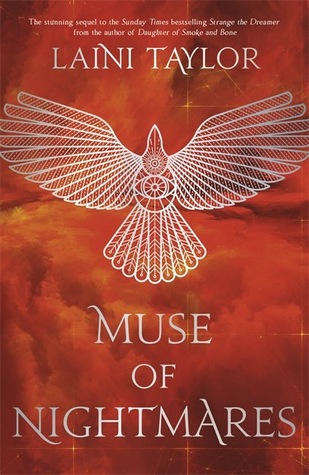Top Ten Tuesday is a weekly feature hosted by That Artsy Reader Girl. Each week there is a new topic for bloggers to choose and list their top ten. This week’s theme is Frequently Used Title Structures for Young Adult Fantasy Books.
This was always something part of me noticed, but that until this Top Ten Tuesday topic I never paid too much attention to. Now I have and it’s become something I can’t get my mind to un-notice.
When it comes to young adult book titles, especially in the fantasy genre, there’s a common structure that seems to be everywhere; ‘[Something] of [Something] and [Something]’. The titles below aren’t even all the ones I was able to find, they’re just all the ones I managed to find before my brain started melting down.

It’s something you see a lot in Laini Taylor’s books. In fact the only book where the title doesn’t have that specific structure is Strange the Dreamer. One book out of six releases.
- Daughter of Smoke and Bone by Laini Taylor
- Days of Blood and Starlight by Laini Taylor
- Night of Cake and Puppets by Laini Taylor
- Dreams of Gods and Monsters by Laini Taylor
- Muse of Nightmares by Laini Taylor


Another author who uses the same, or similar, structures for book titles is Cassandra Clare. Granted a lot of her releases are ‘[Something] of [Something]’ rather than ‘[Something] of [Something] and [Something]’ but they still all count for the purpose of this post.
- City of Bones by Cassandra Clare
In fact the whole of The Mortal Instruments series.

- Lord of Shadows by Cassandra Clare
- Queen of Air and Darkness by Cassandra Clare

- Daughter of the Burning City by Amanda Foody
- Song of the Current by Sarah Tolcser
- Kingdom of Ash and Briars by Hannah West

Sarah J. Maas has used the ‘[Something] of [Something]’ title structure for her Throne of Glass series.
- Throne of Glass by Sarah J. Maas
- Crown of Midnight by Sarah J. Maas
- Heir of Fire by Sarah J. Maas
- Queen of Shadows by Sarah J. Maas
- Empire of Storms by Sarah J. Maas
- Tower of Dawn by Sarah J. Maas

And Rick Riordan started doing the same with his Heroes of Olympus series.
- The Son of Neptune by Rick Riordan
- The Mark of Athena by Rick Riordan
- The House of Hades by Rick Riordan
- The Blood of Olympus by Rick Riordan

- The Game of Love and Death by Martha Brockenbrough
- Children of Blood and Bone by Tomi Adeyemi
- The City of Brass by S.A. Chakraborty

So what do you think? Did you take part in this week’s Top Ten Tuesday, if so let me know what common words or title structures you see in the books you read. Is your brain as battered as mine after reading this post, is this something you’re ever going to be able to un-notice?
If the answer is no I clearly haven’t done the job I set out to do with this post.

Ooh I love the way to play this week’s topic, instead of using the keyword you are using the structure 😀 I think for Clare, Taylor, and Riordan are because they are in the same series. TMI using the City of [something], TID using Clockwork [something]… But the format became very overused in YA, especially since most YA titles are incorporating the same word over and over again?? I find myself confusing one book for another more than once!
LikeLiked by 1 person
Thanks so much. 🙂 Yeah I struggled to think of one word but I realised there were a lot of books with the same structure. Granted it makes sense in series, and connects the books, but then you look at it kind of in terms of the genre overall and realise how overused it can be.
Oh I’ve done that a couple of times. I was actually 100% convinced I’d read a book I’d actually never picked up before just because the two titles were so similar. 🙂
LikeLike
This is so true 😂 As a massive fantasy reader, I always chuckle when a new book comes out like “Kingdom of Blood and Fire” – at least it makes it super obvious what genre is it!
LikeLiked by 1 person
Ha, yeah you’re never going to pick up the wrong genre by mistake are you? Not when all the titles are so similar. 😀
LikeLike
Oh my god, that’s so weird? I think I always noticed it (like in TMI and DoSaB because they were series and I guessed that they were meant to be that way) but I never saw it with Throne of Glass or Heroes of Olympus?? That’s so weird!
And I feel like a lot of books have “of” in them these days, for some reason. One pattern I’ve found is with “girl”, “made”, and “of”. For example, Girls Made of Snow and Glass, Girl Made of Stars, and Girls of Paper and Fire. (I feel like I messed up all of those titles now. 😂)
Great post, Beth!
LikeLiked by 1 person
Yeah in series it makes sense because it’s a way of connecting the books isn’t it? Honestly I just never realised how many books had this title structure, I kind of noticed them separately but never together you know?
Ha, I’m not sure if those are the correct titles but I know what books you mean and yeah there are a lot of titles with that pattern too.
Thanks so much May. 😀
LikeLike
I never think about things like this until people do these lists and then I’m like damn, titles are so unoriginal. Patterns everywhere! If I ever write a book, must make sure it doesn’t use the common key words.
LikeLiked by 1 person
Yeah the things I’ve realised thanks to this weeks TTT theme is kind of funny. It’s strange how you don’t tend to notice until someone else points it out right?
Ha, yeah I said that myself, this is kind of a do-not guide for naming your own novel. 😀
LikeLike
Always the way, people draw your attention to something and then that’s all you see. Haha.
Yep, definitely a solid do-not guide.
LikeLiked by 1 person
Oh yes, you’re right! It’s impossible to unsee it once you point it out!! I’ve got to admit that I’m a bit of a fan of this particular structure- even if it is everywhere right now 😉 But well spotted!
Excellent post! 😀 ❤
LikeLiked by 1 person
Yeah, and I feel like now I have pointed it out I’m going to be seeing it everywhere, even more than I would have before! It works well for YA fantasy books for sure, I mean it’s everywhere so it must be a successful formula for a title! 🙂 Thanks so much. 🙂 ❤️
LikeLiked by 1 person
hehe yes! That’s true! And you’re welcome! 🙂 ❤
LikeLiked by 1 person
It really is something we can’t un-notice now…. thank you for that, Beth! With this week’s topic, I noticed all of the patterns in YA book-titles and now… I’m just seeing it everywhere, the similarities, the names, everything looks the same and I am having an existential crisis about it all hahahaha.
Fantastic post! 🙂
LikeLiked by 1 person
Ha, that all right. 😀 And yeah I get what you mean because there are a few things that are going to stay stuck in my mind now from this week’s theme. It really is something you don’t tend to notice until it’s pointed out like this, then you just can’t ignore it. Existential crisis sounds about right! Does give me some ideas about what not to name my WIP though . 🙂
Thanks so much. 😀 ❤
LikeLiked by 1 person
That’s a cool list… !!!
LikeLiked by 1 person
Thanks so much. 🙂
LikeLiked by 1 person
Oh my gods! I can’t believe I have never noticed this… This is a great list.
LikeLiked by 1 person
Ha, yeah it took me a while to make the connection, it was only actually thinking of topics for this post that it finally clicked in my brain. 😀
Thanks so much. 🙂
LikeLiked by 1 person
And once you see it, you cannot unsee it 🙈😂
LikeLiked by 1 person
This does seem like a popular trend nowadays! Great list!
LikeLiked by 1 person
I suppose it’s an easy way to identify, just using the title, which genre books fall into. You don’t even need the cover or blurb do you.
Thanks so much. 🙂
LikeLiked by 1 person
Huh. I never would have thought of this. Now, I’m going to notice it every time I look at one of these types of books. Good job educating us all!
LikeLiked by 1 person
Thanks so much, and yeah this kind of thing tends to be something we don’t notice until it’s pointed out to us. Then it’s all we can see! 🙂
LikeLiked by 1 person
…Now that you’ve pointed it out, I can’t un-see it, haha.
LikeLiked by 1 person
I feel like it’s going to be a while before any of us can un-see it! 🙂
LikeLiked by 1 person
You’re right! Now I’m not going to be able to un-notice this trend. Ha ha.
Happy TTT!
Susan
http://www.blogginboutbooks.com
LikeLiked by 1 person
Ha, yeah it’s going to take me a while to un-notice this as well, and if I have to try I need everyone else to join me! 🙂
Thanks. 😀
LikeLike
I am not a YA reader, however I did read Daughter of Smoke and Bone, and there are many good posts about YA this week. I did one on my genre-HR. I am a new visitor/subscriber!
https://justmeandmyblogreviews.blogspot.com/2018/04/top-ten-tuesday-ten-frequently-used.html
LikeLiked by 1 person
Oh Daughter of Smoke and Bone is a brilliant read, so if you don’t get through much YA at least you’re getting through the best (in my opinion!)
Thanks for the link, I’ll definitely check out your post. 🙂
LikeLike
There are so many similarities that sometimes I get titles mixed up!
LikeLiked by 1 person
Oh yeah I completely get that, with so many similar titles I guess some of the books will blur together a little right? 🙂
LikeLike
Omg so many something of something books I never realized!! great list!!!
LikeLiked by 1 person
Ha, yeah I didn’t notice myself until I was trying to come up with a theme for this weeks TTT, and then it was all I could notice! 🙂
Thanks so much.
LikeLike
Ha! I have never noticed this pattern before, but it’s so obvious now that I’m seeing this! Great answers for this TTT! 😀
LikeLiked by 1 person
Yeah it’s really one of those things that once someone points it out you can’t stop noticing. It’s going to be a while before I manage to get this pattern out of my mind! Thanks so much Meghan! 🙂
LikeLiked by 1 person
Haha I feel you!
You’re welcome! 😀
LikeLiked by 1 person
Great answers Beth! I’ve only seen others do ‘words’ so it’s nice to see title structures, def see the similarities. Gahhh Cassie Clare really does know how to give us a great title 🙂
LikeLiked by 1 person
Thanks so much Lilly. 🙂 Yeah I couldn’t think of that many words that stood out the way the sentence structures I featured this week did, and once I started noticing I couldn’t stop! Ha, yeah, must be why all her books include it! 😀
LikeLiked by 1 person
Haha! Agreed 😂
LikeLiked by 1 person